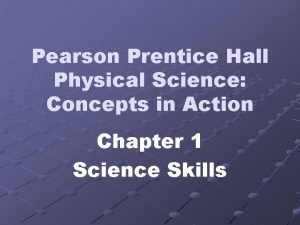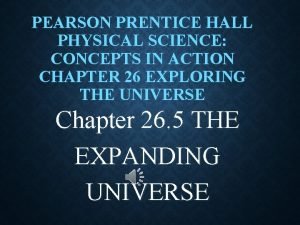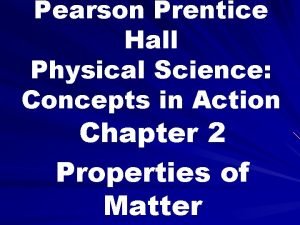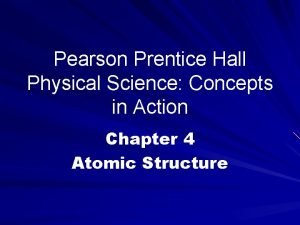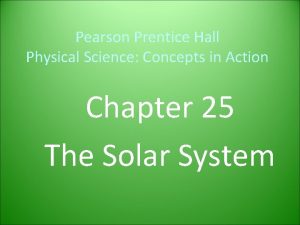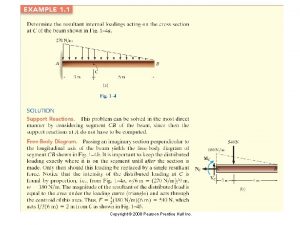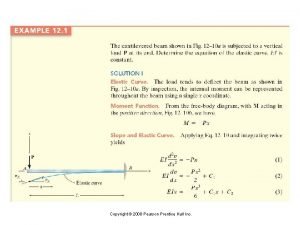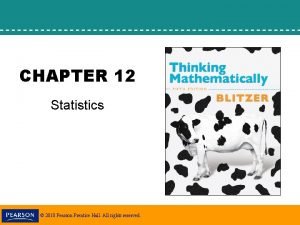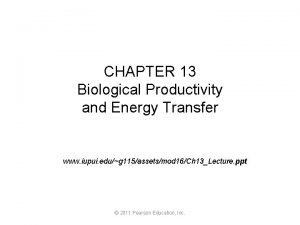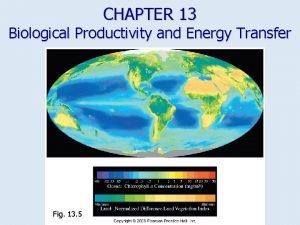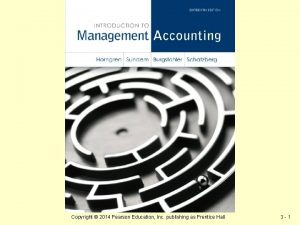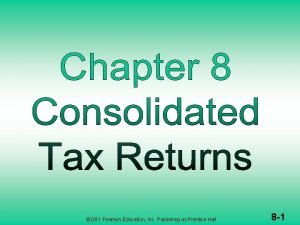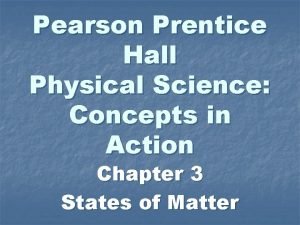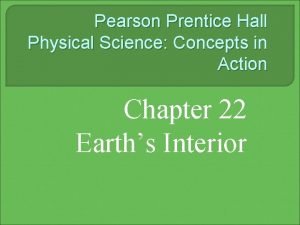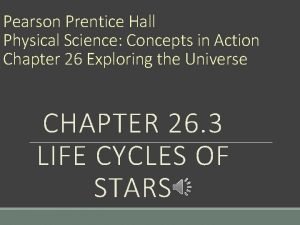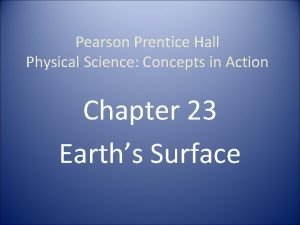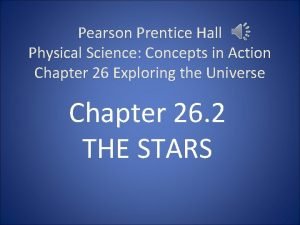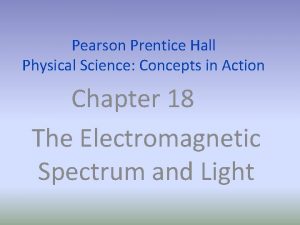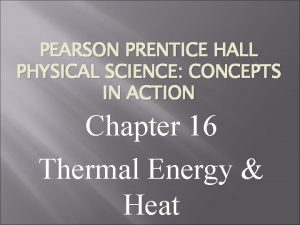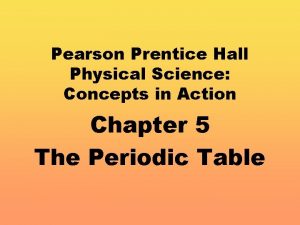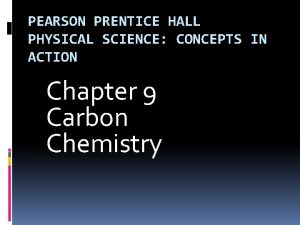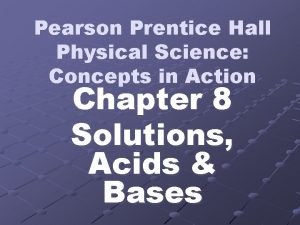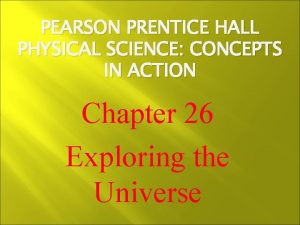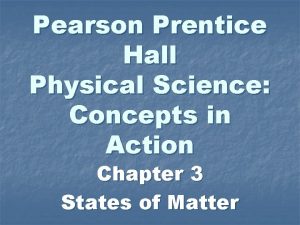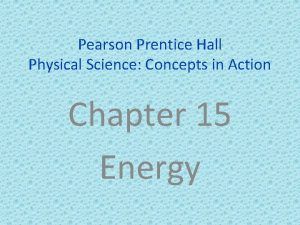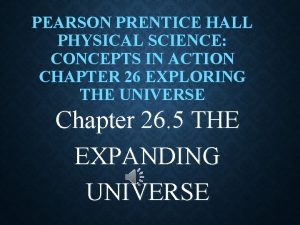Pearson Prentice Hall Physical Science Concepts in Action




















- Slides: 20

Pearson Prentice Hall Physical Science: Concepts in Action Chapter 11 Motion

11. 1 Distance and Displacement • Objectives: • 1. Identify frames of reference and describe how they used to measure motion • 2. Identify appropriate SI units by measuring distances 3. Distinguish between distance and displacement • 4. Calculate displacement using vector addition

Frames of Reference • Definition: a frame of reference is a system of objects that are not moving with respect to one another • Definition: relative motion is movement in relation to a frame of reference • Ex: people standing on the side of the road see the car speeding by, but people in the car look at one another and don’t appear to be moving at all • When describing how fast something is moving, choose a frame of reference that allows you to describe motion in a clear and relevant manner

Distance • Definition: distance is the length of a path between two points • When an object moves in a straight line, the distance is the line connecting the starting point to the ending point • The SI unit for distance is the meter (m) • For long distances, km is appropriate and for distances smaller than one meter, the cm is appropriate

Displacement • Definition: displacement is the direction from the starting point and the length of a straight line from the starting point to the ending point (distance is the length of the total path) • Definition: a vector is a quantity that has magnitude (size, length or amount) and direction (positive/negative, north/south) • Definition: vector addition is the combining of vector magnitudes and directions • Add displacements together using vector addition

Vector Addition • When the displacement isn’t along a straight line, use vector addition • Definition: a resultant vector is the vector sum of two or more vectors • a resultant vector may show displacement • Q: Should your directions to a friend traveling from one city to another include displacements or distances? Explain.

11. 2 Speed and Velocity • Objectives: • 1. Identify appropriate SI units for measuring speed • 2. Compare and contrast average speed and instantaneous speed • 3. Interpret distance-time graphs • 4. Calculate the speed of an object using slopes • 5. Describe how velocities combine

SI Units for Speed + Average & Instantaneous speed • Definition: speed is the ratio of distance moved divided by the amount of time it took • Definition: Average speed is total distance divided by total time for the entire trip • Total distance/total time or v= d/t • Definition: instantaneous speed is speed measured at that moment (ex: speedometer) • The SI unit of speed is meters per second (m/s)

Distance-Time Graphs • Distance versus time graphs are a good way to describe speed • The slope of a distance-time graph is speed

Using Slope

Velocity • Velocity is the description of speed and direction of motion • Velocity is a vector & can be + or – • Two or more velocities add by vector addition • Q: A plane’s average speed is 600 km/h. If the trip takes 2. 5 h, how far does the plane fly? • A: cross cancel the units: (600 km/h)(2. 5 h) = 1500 km

11. 3 Acceleration • Objectives: • 1. Identify changes in motion that produce acceleration • 2. Describe examples of constant acceleration • 3. Calculate the acceleration of an object • 4. Interpret speed-time & distance-time graphs • 5. Describe instantaneous acceleration

Changes in motion • Definition: acceleration is a change in speed, direction or both • Acceleration is a vector • Definition: free fall is the movement of an object toward earth due to gravity alone • Free fall is an example of acceleration and is a change in speed • You can accelerate even if speed is constant by riding a bicycle around a curve (change of direction ) • Riding a carousel is also acceleration

Constant Acceleration • It is possible to change both speed and direction • Ex: riding a roller coaster or driving along a winding road at the posted speed limit • Definition: constant acceleration is a steady change in velocity • This means that the velocity changes by the same amount each second • An example is jet acceleration during a portion of takeoff

Calculate Acceleration • To calculate acceleration for straight-line motion divide the change in velocity by the total time • To find the change in velocity subtract the initial velocity from the final velocity (vf - vi) • Change in velocity = (vf - vi) total time t • To determine a change in velocity subtract one velocity vector from another • If the motion is a straight line, the velocity can be treated as speed • Then find acceleration by change in speed divided by time

Speed-time & Distance-time Graphs • On a linear speed time graph, a positive slope shows positive acceleration

• A negative slope shows negative acceleration

• A distance-time graph of accelerated motion is a curve • It is considered a nonlinear graph • A steeper slope after several seconds on these graphs means that the speed is increasing


Instantaneous Acceleration • Definition: instantaneous acceleration is how fast a velocity is changing at a specific instant or moment in time • Acceleration is rarely constant • Motion is rarely in a straight line • A skateboarder is accelerating but the instantaneous acceleration is always changing
 Prentice hall physical science: concepts in action
Prentice hall physical science: concepts in action Prentice hall publishing
Prentice hall publishing Pearson education 2011
Pearson education 2011 Pearson education inc publishing as pearson prentice hall
Pearson education inc publishing as pearson prentice hall 2012 pearson education inc
2012 pearson education inc 2008 pearson prentice hall inc
2008 pearson prentice hall inc Bacground
Bacground Pearson physical science concepts in action
Pearson physical science concepts in action Pearson physical science concepts in action
Pearson physical science concepts in action Pearson physical science concepts in action
Pearson physical science concepts in action Prentice hall inc
Prentice hall inc 2008 pearson prentice hall inc
2008 pearson prentice hall inc 2005 pearson prentice hall inc
2005 pearson prentice hall inc Pearson prentice hall
Pearson prentice hall Pearson prentice hall
Pearson prentice hall Pearson prentice hall
Pearson prentice hall 2005 pearson prentice hall inc
2005 pearson prentice hall inc Phylum arthropoda common name
Phylum arthropoda common name Pearson education inc. publishing as prentice hall
Pearson education inc. publishing as prentice hall Pearson education, inc. publishing as prentice hall
Pearson education, inc. publishing as prentice hall 2011 pearson education inc
2011 pearson education inc
